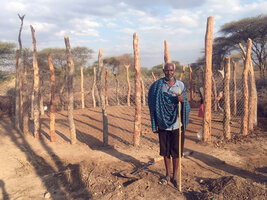~ecology-news-biolog | Bookmarks (451)
-
New method tracks contaminant accumulation in Arctic marine mammals
A new method of tracking the dietary habits and contaminant exposure of animals in Arctic marine...
-
Study finds chain-link fences reduce predator attacks on livestock
A predator's gotta eat, but sometimes what they eat harms people sharing the landscape, and that...
-
How a rapidly growing population of crocs has been impacting Australia's Northern Territories ecosystem
A team of marine biologists, environmental researchers and land management specialists affiliated with several institutions in...
-
Snakes' secret language of ultraviolet color: A hidden world of predator evasion and camouflage
In the study of why and how animals look the way they do, color is king—at...
-
Brown trout can successfully navigate beaver dams, monitoring study shows
A study, led by the University of Southampton (UK), has revealed that brown trout can successfully...
-
Changes in bats' diets can increase spread of viruses and spillover risk
Cornell researcher Raina Plowright and her team observed that when bats in Australia lost access to...
-
World-first analysis of seabirds who've eaten plastic reveals slow, insidious health impacts
We all know microplastics are bad for the environment and our health, but do we really...
-
Overfishing urchins: A paradoxical path to marine sustainability
In our warming oceans, marine species are moving into new areas and "re-engineering" or often destroying...
-
Taking the seagrass taxi: How foraminifera move from the coast to the depths of the Red Sea
Foraminifera are single-celled marine organisms with a calcareous shell. They not only provide evidence of past...
-
A long wait for pollinators: Restored grasslands need 75+ years for full biodiversity recovery, study finds
Recovered grasslands need more than 75 years of continuous management to regain their biodiversity because specialized...
-
What pesticides do to bumble bee brains depends on dose and timing, study reveals
Pesticides, widely used to protect crops from pests, often unintentionally harm pollinators like bumble bees. A...
-
Many animal 'geomorphs' under threat, study warns
More than a quarter of our planet's natural "geomorphs"—animals such as beavers and hippos that, collectively,...
-
Hummingbirds in Andes Mountains found nesting in colonies, defying territorial norms
Recent research by Bowling Green State University scientists has sent shockwaves through the bird-watching world after...
-
AI has untapped potential to advance biodiversity conservation, study finds
A new study from McGill University researchers suggests the use of artificial intelligence (AI) to rapidly...
-
Evaluating bat activity in winter: Southern forests provide a haven for bats amid disease threats
Winter in the South can bring about a sharp change in conditions that impact forests and...
-
Hand pollination helps cocoa farmers offset climate harm
Exploring ways for cocoa farmers to hand pollinate their crops could help offset crop losses resulting...
-
Want to preserve biodiversity? Go big, researchers say
Large, undisturbed forests are better for harboring biodiversity than fragmented landscapes, according to University of Michigan...
-
In the heart of vanilla country, farmers on the front lines of climate change struggle to adapt
As erratic weather upends the seasonal rhythms that crops depend on, farmers in the island nation...
-
Mariana Trench expedition discovers new lifeforms flourishing in deep-sea environment
Shanghai Jiao Tong University along with multiple collaborating institutions including the University of Copenhagen and Lawrence...
-
Whales move nutrients from Alaska to Hawaii in their urine, supporting tropical ecosystems
Whales are not just big, they're a big deal for healthy oceans. When they poop, whales...
-
Shells of their former selves: How sea snails have adapted to invasive predators
Over the past two decades, the Gulf of Maine has become a popular landing spot for...
-
First national analysis finds America's butterflies are disappearing at 'catastrophic' rate
America's butterflies are disappearing because of insecticides, climate change and habitat loss, with the number of...
-
Tooth size in South American sea lions reflects historical shifts in population abundance
A new study published in PeerJ reveals that the teeth of South American sea lions (Otaria...
-
Pollinator diversity in urgent need of protection to ensure ecosystems function properly
Pollinators are animals that help to transport pollen from one location to another in the plant...









